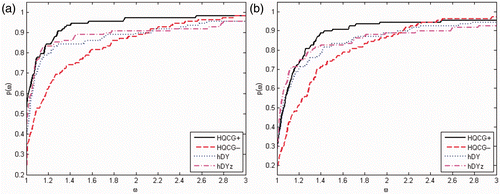Abstract
Here, necessary corrections on computing the hybridization parameter of the quadratic hybrid conjugate gradient method of Babaie-Kafaki [S. Babaie-Kafaki, A hybrid conjugate gradient method based on a quadratic relaxation of Dai-Yuan hybrid conjugate gradient parameter, Optimization, DOI: 10.1080/02331934.2011.611512, 2011] are stated in brief. Throughout, we use the same notations and equation numbers as in Babaie-Kafaki (2011).
1. Two new quadratic hybrid conjugate gradient parameters
Recently, a continuous hybridization of the Dai–Yuan and Hestenes–Stiefel conjugate gradient (CG) parameters has been proposed in Citation1 based on a quadratic relaxation of a hybrid CG parameter proposed by Dai and Yuan Citation3. Although all the theoretical results of Citation1 are correct, its numerical results need some revisions due to an improper choice of the hybridization parameter.
It is remarkable that after some algebraic manipulations, it can be shown that the CG parameter β
k
(θ
k
) defined by (2.5) with the hybridization parameter θ
k
defined by (2.10) is equivalent to and consequently, in (2.14) we have
. Thus, the approach of Citation1 for computing the hybridization parameter θ
k
fails to generate a new CG method. This important defect of Citation1 demonstrates the necessity of proposing new hybridization parameters in order to generate new hybrid CG parameters in the quadratic form of (2.5). Here, two formulae for the hybridization parameter θ
k
is suggested based on the extended conjugacy condition
(t ≥ 0), as mentioned in Remark 2.1 of Citation1. More precisely, from (1.2) at the kth iteration the following quadratic equation is solved for finding the hybridization parameter θ
k
:
Now, we adopt the approach of Citation2 in order to modify the CG parameter β k (θ k ) as follows:
Based on the numerical considerations of Citation2, the CG methods HQCG+ and HQCG– with t = 0.3 have been numerically compared with the CG methods hDY and hDYz. Figure show the comparison results in the sense of the Dolan–Moré performance profile. As shown by the figure, HQCG+ is numerically efficient while HQCG– has a poor numerical performance. It can been shown that the CG methods HQCG+ and HQCG– have the important feature of global convergence for general functions.
Acknowledgements
This research was in part supported by a grant from IPM (no. 90900023), and in part by the Research Council of Semnan University.
References
- Babaie-Kafaki , S . 2011 . A hybrid conjugate gradient method based on a quadratic relaxation of Dai–Yuan hybrid conjugate gradient parameter . Optimization , DOI: 10.1080/02331934.2011.611512
- Babaie-Kafaki , S . 2012 . A quadratic hybridization of Polak–Ribiére–Polyak and Fletcher–Reeves conjugate gradient methods . J. Optim. Theory Appl. , 154 : 916 – 932 .
- Dai , YH and Yuan , YX . 2001 . An efficient hybrid conjugate gradient method for unconstrained optimization . Ann. Oper. Res. , 103 : 33 – 47 .

